Introduction
You are going to learn how to organize the structure of a paper in this lesson, but let’s just pretend that you are planning to go on a trip. There are two kinds of trips you can take. In the first kind, you get in the car and take off. You might take along some money and a smartphone with a GPS, but otherwise the trip starts with only a plan to head north. You let the events of the trip unfold as they may. This adventure involves focus and exploration: You focus on a general direction and see what happens.

Source: Stacked luggage, THOR, Flickr
For the second kind of trip, you map out a route, calculate the hours between motel stops, estimate the amount of money you will need, and plot the return trip so that you are back in time to meet a deadline such as the start of a new school year or the end of your time off from work. This is a thesis-and-support road trip. Before you set out, you know where you are going and how you will get there. The thesis is your route: you know what it is before you start. The support is that you will stop and sleep and then get up and drive toward a specific destination each day.
In academic writing, writers are expected to take readers on thesis-and-support trips, not on focus-and-exploration trips. In other words, in academic writing we expect a plan or structure to the writing, and that structure should be obvious from the first paragraph.
Look back at the first paragraph of this lesson. Is there any indication that this is thesis-and-support style writing? If you look closely, you will see two such indications: two sentences in the first paragraph preview the structure for this part of the lesson.
The first sentence of this lesson informs you about its destination: “You are going to learn how to organize the structure of a paper.” The second sentence is also characteristic of thesis-and-support writing: “There are two kinds of trips you can take.” That sentence may not inform you about where you are going, but it does tell how you are going to get information. This statement makes clear that the writing has been thought out ahead of time. You can’t say something like that unless you have something in mind. This sentence is entirely devoted to telling you, “This writing has a plan.”

Source: Michel de Montaigne, Wikimedia Commons
Now don’t get the idea that freestyle writing is being disparaged. Certainly there are reasons to go on a freeform road trip. By exploring, you will go places, meet people, and make discoveries that you never could have planned. Writing that starts with a focus and just comes out as it comes out can be very valuable. The man credited with inventing the essay back in the 1500s wrote the first essays in this meandering way. His name was Michel de Montaigne. He was born in France and is known as one of the most influential writers of the French Renaissance. His massive volume Essais (which translates literally as “Attempts”) contains some of the most widely influential essays ever written.
So there are some writing tasks that are better suited to, or even require, focus-and-exploration writing. But most academic writing assignments require a thesis and support. Below is a list of different writing tasks; some require thesis-and-support treatment, and some are better served by focus-and-exploration treatment. Drag and drop each item into the category you think is correct.
Academic writing is all about thesis and support. You are rewarded not only for having a plan, but also for making that plan as obvious as possible. In academic writing, it is preferred to let the structure show.
What does it mean to “let the structure show”?
It means that you write sentences like “There are two kinds of trips,” which clearly announce the plan and the organization of your writing.
The example statements that follow might be included in a paper on the benefits of travel. How do these statements “let the structure show”?

Consider each one and use your notes to record
your responses. When you’re finished, check your understanding.
- Travelers can be classified in three ways.
- There is one more important and one less important consideration.
- If you travel, you are bound to discover these things about yourself: your tastes, your intolerances, and your talents.
- Travel is both an adventure and a challenge.
- Some people travel, but in two important ways never leave home.
- I have been on many trips, but there is one that stands out to me as life changing.
Sample Responses:
- This is clearly exposing a plan because it tells the reader there will be three parts.
- The writer implies that the paper will discuss two considerations.
- This sentence actually names the various stops on your trip and what you will discover about each.
- Although there are no numbered steps indicated by this statement, it promises a discussion of two different aspects of travel: adventure and challenge.
- This sentence implies that some travelers do not embrace new experiences.
- This sentence has the weakest plan, which is not necessarily bad at this point; the structure, however, does not show. All we know is that there will be a discussion of a life-changing trip.
Remember that in academic writing, the structure should show.